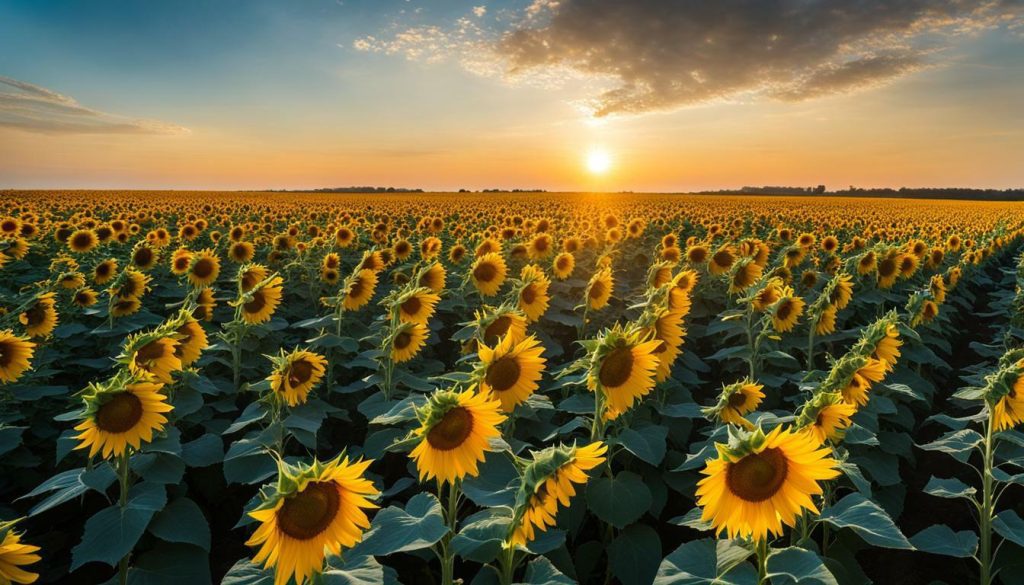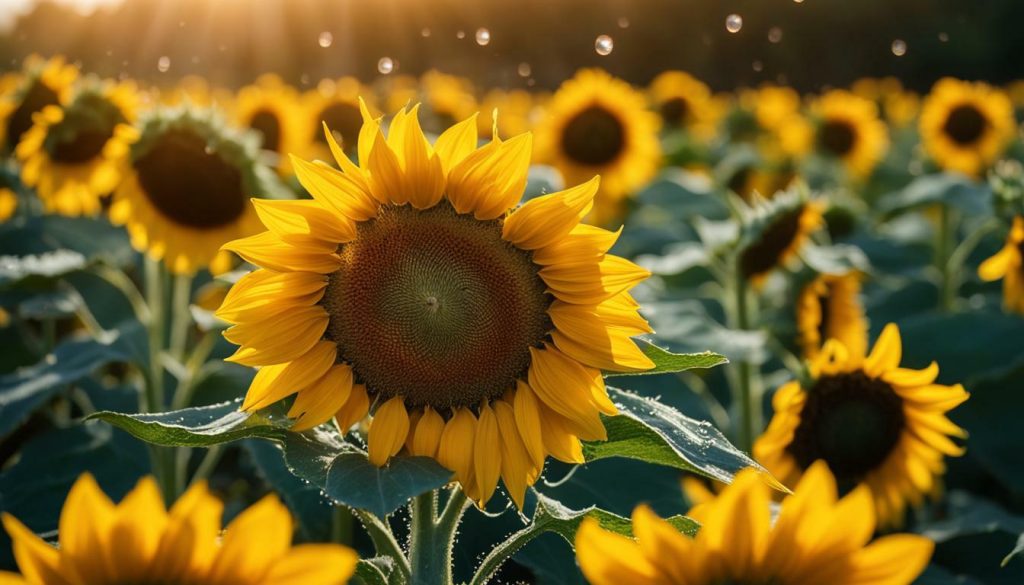

Are you ready to transform your garden into a sunflower paradise? With these sunflower field tips, you’ll be well on your way to growing healthy, beautiful sunflowers and creating a show-stopping garden.
When it comes to discovering the best sunflower fields for unbeatable blooms, research is key. Sunflowers typically bloom from mid-summer to late fall, with the high season occurring from late July to early September. To capture the perfect shots, head to the fields during the “golden hour” of sunrise or sunset when the lighting is at its best for photography.
To ensure you’re fully prepared for your sunflower photography adventure, consider bringing a DSLR camera along with wide-angle and macro lenses. A tripod and polarizing filter can also enhance your images. Don’t forget to dress appropriately for the outdoor conditions, applying sunscreen and insect repellent to protect yourself.
Once you’re in the sunflower fields, get creative with your photography. Try isolating a single flower or a group of flowers to capture their beauty. With a macro lens, you can zoom in and showcase intricate details. Experiment with different angles, going low and utilizing backlighting for dramatic effects.
Remember, while you’re enjoying the fields, be respectful of the flowers and the environment. Avoid causing any damage or trampling the fields to preserve their natural beauty for future visitors.
Key Takeaways:
- Do your research to find the best sunflower fields for optimal blooming periods.
- Capture sunflower photos during the “golden hour” of sunrise or sunset.
- Pack your DSLR camera, wide-angle and macro lenses, tripod, and polarizing filter for stunning shots.
- Dress appropriately for outdoor conditions, including sunscreen and insect repellent.
- Get creative with your photography by experimenting with angles, isolating flowers, and utilizing backlighting.
How to Plant Sunflower Seeds and Choose the Right Varieties
Before you can enjoy the vibrant blooms of sunflowers, it’s important to start with the right planting techniques and varieties. Let’s dive into the step-by-step process of planting sunflower seeds and finding the perfect sunflower varieties for your space.
Step 1: Prepare the Soil
Start by choosing a location that receives full sun for at least 6-8 hours a day. Sunflowers thrive in well-draining soil, so prepare the soil by loosening it with a garden fork or tiller. Remove any weeds or rocks that may hinder the growth of your sunflowers.
Next, enrich the soil with organic matter, such as compost or well-rotted manure, to provide the necessary nutrients for healthy growth. Work the organic matter into the soil, ensuring it is evenly distributed.
Step 2: Planting Sunflower Seeds
When it comes to planting sunflower seeds, follow these simple steps:
- Make 1-inch deep holes in the soil, spaced about 6-12 inches apart, depending on the variety. Larger varieties require more space, while smaller ones can be planted closer together.
- Drop one sunflower seed into each hole and cover it with soil.
- Water the soil gently to ensure the seeds are moist but not soaked.
Remember to label your planting rows to keep track of the variety and planting date.
Step 3: Choosing the Right Sunflower Varieties
There are numerous sunflower varieties available, each with its own unique characteristics. Consider the following factors when choosing the right variety:
- Height: Determine the height you desire for your sunflowers. Some varieties can grow as tall as 12 feet, while others stay compact at around 2-3 feet.
- Color: Sunflowers come in various colors, including vibrant yellows, oranges, and reds. Choose a color that complements your garden or personal preference.
- Bloom time: Different varieties have different bloom times. Consider selecting a combination of early, mid, and late blooming varieties to extend the flowering period.
Consult with local nurseries or gardening experts to learn more about the sunflower varieties that thrive in your specific region.
By following these planting techniques and selecting the right sunflower varieties, you’ll be well on your way to enjoying a spectacular sunflower display in your own garden or field.
| Variety | Height (inches) | Color | Bloom Time |
|---|---|---|---|
| Sunbeam | 60-72 | Yellow | Early to mid-summer |
| Autumn Beauty | 60-72 | Mixed colors | Mid to late summer |
| Moulin Rouge | 36-48 | Deep red | Late summer to fall |
Remember to water your sunflowers regularly, especially during dry spells, and to remove any dead blooms to promote continuous blooming. With proper care and attention, your sunflowers will reward you with a stunning display of beauty.


Essential Sunflower Care and Maintenance Tips
Once your sunflowers have sprouted, they require proper care and maintenance to reach their full potential. Let’s explore the essential tips for nurturing your sunflowers and keeping them in peak condition.
- Watering: Sunflowers need regular watering, especially during hot, dry periods. Aim to provide about 1 inch of water per week, making sure the soil is evenly moist but not waterlogged. Water at the base of the plant to avoid wetting the foliage, which can lead to diseases.
- Fertilizing: To promote healthy growth and vibrant blooms, fertilize your sunflowers once a month with a balanced, water-soluble fertilizer. Look for a fertilizer with equal amounts of nitrogen, phosphorus, and potassium (NPK), such as a 10-10-10 formula. Apply the fertilizer according to the packaging instructions.
- Staking: As sunflowers grow tall and heavy, they may require staking to prevent toppling over. Place stakes in the ground near the base of the plant and gently tie the stems to the stakes with soft ties or twine. This will provide support and keep your sunflowers upright and sturdy.


“Sunflowers need regular watering, especially during hot, dry periods.”
“As sunflowers grow tall and heavy, they may require staking to prevent toppling over.”
Sunflower Pests and Diseases
Sunflowers are generally resistant to many pests and diseases, but it’s important to monitor your plants closely for signs of trouble. Common pests that may affect sunflowers include aphids, slugs, and snails. If you notice any infestations, you can use organic insecticides or handpick the pests.
When it comes to diseases, sunflowers can be susceptible to fungal infections such as powdery mildew and downy mildew. To prevent these diseases, avoid overhead watering, provide adequate spacing between plants for good air circulation, and remove any infected leaves or plants promptly.
| Pest/Disease | Symptoms | Treatment |
|---|---|---|
| Aphids | Clustering of tiny insects on leaves and stems | Use insecticidal soap or neem oil spray, or spray with a strong stream of water |
| Powdery Mildew | White powdery spots on leaves and stems | Remove infected leaves, improve air circulation, and apply fungicidal spray |
| Downy Mildew | Yellow or brown patches on leaves, sometimes with fuzzy growth on the undersides | Remove infected leaves, improve air circulation, and apply fungicidal spray |
By following these essential care and maintenance tips, you can ensure that your sunflowers thrive and produce an abundance of beautiful blooms. With proper watering, fertilizing, staking, and pest and disease management, your sunflower garden will be a sight to behold.
Congratulations on learning the top sunflower field tips!
With these expert suggestions and your newfound knowledge, you can confidently grow and maintain a beautiful sunflower garden that will impress everyone who sees it.
When it comes to sunflower garden ideas, there are endless possibilities to unleash your creativity. One popular option is to create a vibrant sunflower border along the edges of your garden or walkway. This not only adds a pop of color to your outdoor space but also acts as a natural fence, creating a sense of privacy.
Another stunning idea is to incorporate sunflowers into your existing flower beds or planters. Their bright yellow petals will complement a variety of other flowers and add a cheerful touch to your arrangements. You can also mix different sunflower varieties to create a beautiful blend of colors and heights.
If you’re feeling adventurous, why not create a dedicated sunflower field? Clear out a larger area of your garden or find an open space where you can plant rows of sunflowers. This will create a striking visual impact and provide an excellent backdrop for outdoor gatherings and photo opportunities.
Remember, sunflowers are not only beautiful but also attract beneficial pollinators to your garden. So, get creative and let your sunflowers shine, bringing joy and beauty to your outdoor space!
FAQ
When is the best time to visit sunflower fields?
Sunflowers bloom from mid-summer to late fall, with the high season typically being late July to early September.
What is the best lighting for photographing sunflowers?
The “golden hour” of sunrise and sunset provides the best lighting for photography.
What photography equipment should I bring to capture sunflowers?
It is recommended to bring a DSLR camera, wide-angle and macro lenses, a tripod, and a polarizing filter.
How should I dress when visiting sunflower fields?
Dress appropriately for outdoor conditions, including sunscreen and insect repellent.
What are some tips for photographing sunflowers?
When photographing sunflowers, try isolating a single flower or a group of flowers, or get up close with a macro lens to capture intricate details. Experiment with different angles, go low, and utilize backlighting for dramatic effects.
How should I behave when visiting sunflower fields?
Be respectful and do not harm the flowers or trample the fields.






